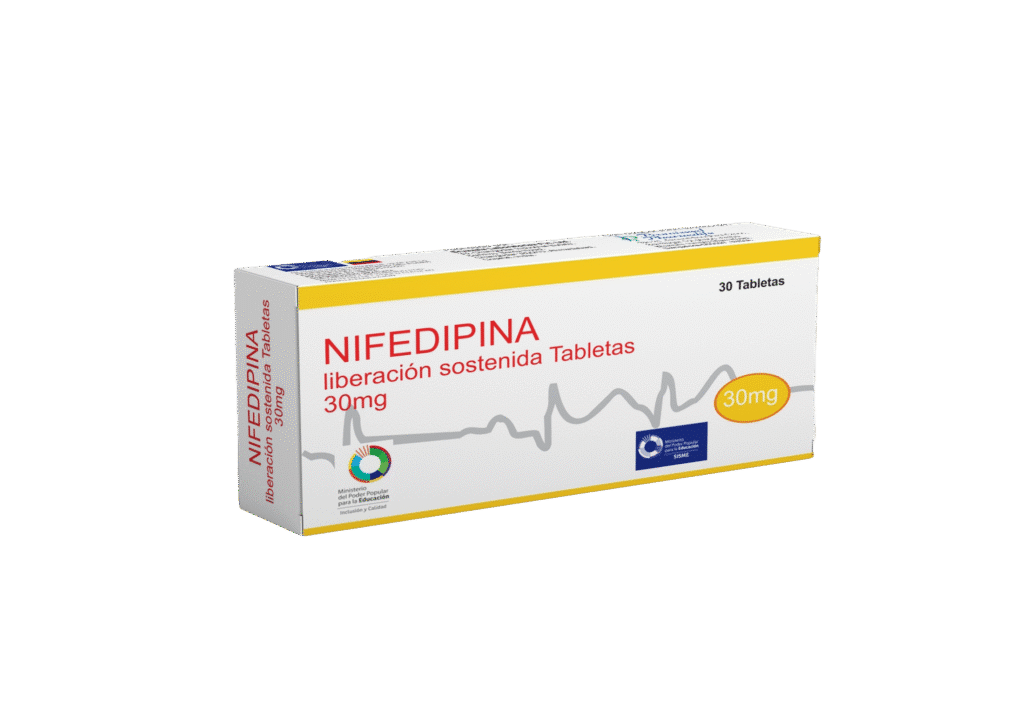







What Nifedipine 30 mg Sustained-Release Tablets Are Used For
Nifedipine extended-release tablets 30 mg are basically used in the treatment of hypertension.
1. High Blood Pressure (Hypertension)
2. Chest Pain (Angina)
Precautions while taking Nifedipine 30 mg sustained-release tablet.
If you’re taking any of these, your doctor may need to adjust your dose and monitor your blood pressure.
How to Take a Nifedipine 30 mg Sustained Release Tablet?
For High Blood Pressure (Hypertension)
For Chest Pain (Angina Pectoris)
Switching from Other Heart Medicines
Drug Interactions
How Long to Take It
| Group | Adjustment Needed? | Notes |
| Elderly (65+) | No | No dose change is needed based on age alone. |
| Kidney Problems | No | Safe to use without changing the dose. |
Possible Side Effects of Nifedipine 30 mg Sustained-Release Tablet.
Nervous System
Common: Headache
Uncommon: Dizziness, migraine, shaky hands
Rare: Tingling or numbness
Not Known: Drowsiness, reduced sensation
Heart & Blood Vessels
Common: Swelling in legs or feet (edema), widening of blood vessels
Uncommon: Fast heartbeat, feeling your heart race, low blood pressure, fainting
Not Known: Chest pain (angina)
General Feelings
Common: Feeling unwell
Uncommon: General pain, chills
Immune System
Uncommon: Allergic reactions, swelling (including throat swelling*)
Rare: Itchy skin, rash, hives
Not Known: Severe allergic reactions (anaphylaxis)
Mental Health
Uncommon: Anxiety, trouble sleeping
Not Known: Depression
Eyes
Uncommon: Blurred or changed vision
Not Known: Eye pain
Muscles & Joints
Uncommon: Joint swelling, muscle cramps
Not Known: Nosebleeds, stuffy nose
Digestive System
Common: Constipation
Uncommon: Stomach pain, nausea, indigestion, gas, dry mouth
Rare: Gum overgrowth
Not Known: Vomiting, difficulty swallowing, intestinal blockage or ulcers
Liver
Uncommon: Temporary rise in liver enzymes (seen in blood tests)
Skin
Uncommon: Redness
Rare: Rash, itching, hives
Not Known: Severe skin reactions, purple spots, sun sensitivity
Kidneys & Urinary System
Uncommon: Frequent urination, pain while urinating
Reproductive System
Uncommon: Erectile dysfunction
Blood Disorders
Not Known: Low white blood cell count (can affect immunity), high blood sugar
Special Warnings
Throat swelling (larynx edema) can be life-threatening.
In dialysis patients with severe high blood pressure and low blood volume, a sharp drop in blood pressure may occur.
Rare digestive blockages (called bezoars) may happen and sometimes need surgery.
Store below 30°C.
Keep out of reach of children.
3×10 Alu/PVC Blister
Nifedipine 30 mg sustained release The tablet is available in an Alu/PVC blister of 10 tablets.
Such 3 blisters in a unit carton with a package insert.
Contact us directly to receive full information on the product, the formulation, the science behind it, stability data, and more. Our Business Development Manager is a click away.
Questions are useful tools, they open lines of communication; give us information; improve interactions, facilitate analysis, and many more.
A pharma CMO is a special kind of an organization, offering contract manufacturing services to pharmaceutical companies for various kinds of drug formulations.
Reduce overall costs and time to market :
Contract manufacturers already have the needed infrastructure and technical staff, so working with a CMO or CDMO can decrease the cost of manufacturing your pharmaceutical products.
Scalability and flexible production capacity :
You can produce what you need when you need it without worrying about excess capacity. Additionally, CMOs understand the importance of quality and compliance, so you don't have to sacrifice safety for scalability.
Save on upgrading and maintaining equipment :
If you have your manufacturing facility, you’ll have to pay to upgrade your equipment as technology advances—which can get expensive. A CMO/CDMO’s only function is to make and distribute products, so part of their core business responsibility is to update their equipment whenever needed and perform maintenance.
Ease supply chain issues :
During the pandemic, there were several instances of supply chain issues, including medicine shortages. CMOs are generally better equipped than startups to handle a supply chain crisis.
Bandwidth to focus on core competencies
When your company resources aren’t directly allocated to manufacturing and distribution, you have more time to focus on other tasks, like marketing your new drug, researching, or working on drug discovery.
We have 7+ manufacturing sites with a minimum of WHO GMP certification and other country-specific approvals like NAFDAC approved, PPK Kenya Approved, TFDA Tanzania Approved, EU-GMP Approved.
We have below manufacturing capacity:
For Tablet, Capsule, and soft gel: up to 1 million units per shift
For Syrup: up to 0.05 Million per shift
For Ampoule and Vial: up to 0.1 million units per shift
For Ointment and Cream: up to 0.1 million units per shift
For Suppository: 0.1 Million units per shift
